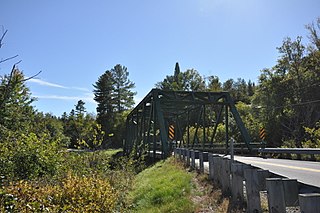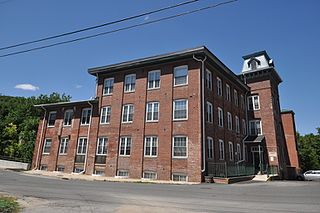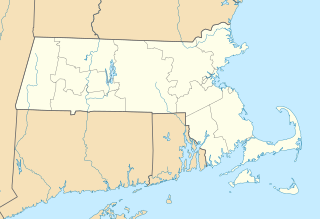
Deep River is a town in Middlesex County, Connecticut. The population was 4,629 at the 2010 census. The town center is also designated by the U.S. Census Bureau as a census-designated place (CDP). Deep River is part of what the locals call the "Tri-town Area" made up of Deep River, Chester, and Essex, Connecticut.

Bellows Falls is an incorporated village located in the town of Rockingham in Windham County, Vermont, United States. The population was 3,148 at the 2010 census. Bellows Falls is home to the Green Mountain Railroad, a heritage railroad; the annual Roots on the River Festival; and the No Film Film Festival.

Ivoryton is one of three villages in Essex, Connecticut in Middlesex County. Ivoryton Historic District, the historic district in the village, was listed on the National Register of Historic Places on April 15, 2014.

The Russell Company Upper Mill is an historic structure in Middletown, Connecticut, built in 1836 and listed on the National Register of Historic Places. The building stands at the junction of Russell Street and East Main Street in South Farms. There is a small pond to the south. East Main Street's commercial and industrial development ends there. To the north, small businesses border the street, followed by the buildings of Russell Manufacturing Company, the area's most dominant feature. Russell Street crosses Sumner Brook nearby and ascends to a large residential district to the west. The mill is currently a condo-apartment complex.

The Starr Mill Road Bridge is a historic bridge in Middletown, Connecticut. It is a single span Warren through truss bridge, spanning the Coginchaug River near the Starr Mill complex on the west bank of the river. Built in 1927 by the Berlin Construction Company, it is one of a shrinking number of period metal truss bridges in the state. The bridge was listed on the National Register of Historic Places in 1993. It is closed to all forms of passage.

The Talcottville Historic District is a historic district in the town of Vernon, Connecticut. Centered on Elm Hill Road and Main Street, it encompasses a 19th-century mill village, including archaeological remnants of very early cotton-spinning facilities, and old stone dam, and a major wood-frame mill constructed by the Talcott brothers. Also included in the village are a significant number of mill worker housing units, many dating to the middle decades of the 19th century, and an 1891 lenticular pony truss bridge, built by the Berlin Iron Bridge Company. The district was listed on the National Register of Historic Places in 1989.
Pratt-Read is an American manufacturing company based in Sycamore, Illinois, that produces screwdrivers. It is a subsidiary of Ideal Industries. Founded in 1798, it is one of the oldest companies in the United States.

The Nashua Manufacturing Company Historic District in Nashua, New Hampshire, is a historic district that was listed on the National Register of Historic Places (NRHP) in 1987. It encompasses an area just west of downtown Nashua, roughly located along the southern bank of the Nashua River, bordered on the west side by Mine Falls Park, on the south side by the Nashua River canal, up to Ledge Street, and from the east side by Factory, Pine and Water streets, up to the Main Street bridge.
The Shore Line Electric Railway was a trolley line along the southern coastline of Connecticut, running between New Haven and Old Saybrook with additional branches to Chester and Stony Creek. Unlike most trolley lines in New England, the Shore Line Electric was a true interurban, running large railway-style cars largely on a private right-of-way rather than on public streets. Though its main line was in operation for only 15 nonconsecutive years, the Shore Line Electric briefly acquired a substantial network of trolley lines stretching across eastern Connecticut, including the Norwich and Westerly Railway, the Groton and Stonington Street Railway, and several lines of the Connecticut Company. Most of the trolley line no longer is extant, however, the Shore Line Electric Railway Power House still stands along the mouth of the Connecticut River in Old Saybrook.

The Cocheco Mills are a historic mill complex in the heart of Dover, New Hampshire. The mills occupy a site at a bend in the Cocheco River that has been the site of industrial activity since at least 1822, when the Dover Cotton Factory was built there. The present mill buildings were built between the 1880s and the early 20th century, and were listed on the National Register of Historic Places in 2014.

The Bloomfield-Nulhegan River Route 102 Bridge is a historic bridge in Bloomfield, Vermont. It carries Vermont Route 102 over the Nulhegan River, near its mouth at the Connecticut River just south of Bloomfield Village. Built in 1937, it is a well-preserved example of a Pratt through truss, exhibiting then state-of-the-art engineering. It was listed on the National Register of Historic Places in 1991.

The Clark Brothers Factory No. 1 was a historic industrial complex at 1331 South Main Street in the Milldale area of Southington, Connecticut. Developed beginning in the 1850s, it was one of the nation's largest sources of carriage bolts. The complex listed on the National Register of Historic Places in 1988 consisted of a group of brick buildings dating to 1893 and later. It has since been entirely demolished, and the land stands vacant and overgrown.

The Bellows Falls Co-operative Creamery Complex is a historic industrial property in Bellows Falls, Vermont. Developed over a period of about 40 years beginning c. 1906, the complex, with two surviving buildings, it represents one of Vermont's largest commercial enterprises of the period. The property, located on the eastern side of Bellows Falls Island, was listed on the National Register of Historic Places in 1990.

The Bellows Falls Times Building is a historic newspaper plant on Bridge and Island Streets in Bellows Falls, Vermont. The complex of three buildings was developed in the 1930s by the Vermont Newspaper Corporation, and served as home for the Bellows Falls Times newspaper until 1965, when it was consolidated with other local newspapers. The main building is a particularly fine local example of Colonial Revival design. The complex was listed on the National Register of Historic Places in 1990.

Sohmer and Company Piano Factory is a historic piano factory located in the Astoria neighborhood of Queens, New York City. It was built in 1886 by Sohmer & Co., and is a six-story, "L"-shaped, Rundbogenstil / Romanesque Revival style brick building. The corner features a clock tower with a copper trimmed mansard roof. The building was expanded about 1906–1907. It was converted to residential usage starting in 2007.

The Gilbert Clock Factory is a historic factory complex at 13 Wallens Street in Winchester, Connecticut. Developed between 1871 and 1897, its surviving elements are a preservation of the state's history as a center for the manufacture of low-cost clocks. The company was one of the town's largest employers for many years. The surviving buildings were listed on the National Register of Historic Places in 1984; they now house apartments.

The Curtisville Historic District encompasses a predominantly residential area along Naubuc Avenue and Pratt Streets in northwestern Glastonbury, Connecticut. Developed mainly in the 19th century, it illustrates the coexistence of agricultural and industrial pursuits in a single village area, mixing worker housing, former farm properties, and a small mill complex. The district was listed on the National Register of Historic Places in 1992.

The Depot Street Bridge is a historic bridge in Beacon Falls, Connecticut, carrying Depot Street over the Naugatuck River. Built in 1935 with federal jobs relief funds, it is one of a small number of surviving Parker through truss bridges in the state. It was listed on the National Register of Historic Places in 2007.

The Home Woolen Company is a historic textile mill complex on Main Street in Beacon Falls, Connecticut. Developed between 1853 and 1916, the complex housed major local employers, engaged first in the manufacture of woolens and rubber products. The complex has been converted to residential use. It was listed on the National Register of Historic Places in 1984.

The Watson, Newell & Company Factory is a historic industrial complex at 67 Mechanic Street in Attleboro, Massachusetts. Built between 1889 and 1947, it is located on the site of the city's first textile mill, and was home to a prominent jewelry manufacturer for many years. It was listed on the National Register of Historic Places in 2020.


















